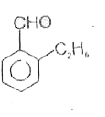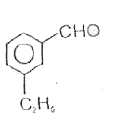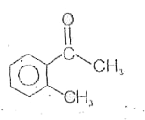An aromatic compound X with molecular formula C9H10O gives following chemical tests:
(i) Form 2,4-DNP derivative
(ii) Reduces Tollen's reagent
(iii) undergoes Cannizzaro's reaction
(iv) On vigorous oxidation 1, 2-Benzene dicarboxylic acid is obtained
The compound X is ,




The correct Answer is:A
To solve the problem, we need to analyze the given information about the aromatic compound X with the molecular formula C9H10O and the results of its chemical tests.
1. Identify the Molecular Formula:
The compound has a molecular formula of C9H10O. This indicates that it is an aromatic compound since it contains a benzene ring.
Hint: Look for the presence of a benzene ring in the structure based on the molecular formula.
2. Chemical Tests Analysis:
- Test (i): The compound forms a 2,4-DNP derivative. This indicates that the compound contains a carbonyl group (C=O), which is characteristic of aldehydes and ketones.
- Test (ii): The compound reduces Tollen's reagent. This is a specific test for aldehydes, confirming that the compound is likely an aldehyde.
- Test (iii): The compound undergoes Cannizzaro's reaction. This reaction occurs with aldehydes that do not have alpha-hydrogens, indicating that the carbonyl group is directly attached to the benzene ring.
- Test (iv): On vigorous oxidation, the compound yields 1,2-benzene dicarboxylic acid. This suggests that the compound is ortho-substituted, as only ortho-substituted benzaldehydes can give this product upon oxidation.
Hint: Each test provides clues about the functional groups and structure of the compound. Pay attention to the implications of each test.
3. Determine the Structure:
Given that the compound is an aldehyde (from tests i and ii) and undergoes Cannizzaro's reaction (test iii), we can conclude that the carbonyl group (CHO) is directly attached to the benzene ring.
Since the oxidation leads to 1,2-benzene dicarboxylic acid, the compound must be an ortho-substituted benzaldehyde.
Hint: Consider the structural implications of being ortho-substituted when determining the final structure.
4. Count the Carbons:
The molecular formula C9H10O indicates:
- 6 carbons in the benzene ring
- 1 carbon in the carbonyl group (CHO)
- This leaves 2 carbons, which must be part of an ethyl group (C2H5).
Therefore, the structure of the compound can be deduced as 2-ethylbenzaldehyde.
Hint: Use the molecular formula to deduce the number of substituents and their positions.
5. Final Structure:
The final structure of compound X is 2-ethylbenzaldehyde, which can be represented as follows:
- A benzene ring with an ethyl group (C2H5) at the ortho position relative to the carbonyl group (CHO).
Hint: Visualize the structure to confirm the placement of the substituents based on the deductions made.
Conclusion:
The compound X is 2-ethylbenzaldehyde (C9H10O).
The compound has a molecular formula of C9H10O. This indicates that it is an aromatic compound since it contains a benzene ring.
- Test (i): The compound forms a 2,4-DNP derivative. This indicates that the compound contains a carbonyl group (C=O), which is characteristic of aldehydes and ketones.
- Test (ii): The compound reduces Tollen's reagent. This is a specific test for aldehydes, confirming that the compound is likely an aldehyde.
- Test (iii): The compound undergoes Cannizzaro's reaction. This reaction occurs with aldehydes that do not have alpha-hydrogens, indicating that the carbonyl group is directly attached to the benzene ring.
- Test (iv): On vigorous oxidation, the compound yields 1,2-benzene dicarboxylic acid. This suggests that the compound is ortho-substituted, as only ortho-substituted benzaldehydes can give this product upon oxidation.
Given that the compound is an aldehyde (from tests i and ii) and undergoes Cannizzaro's reaction (test iii), we can conclude that the carbonyl group (CHO) is directly attached to the benzene ring.
The molecular formula C9H10O indicates:
- 6 carbons in the benzene ring
- 1 carbon in the carbonyl group (CHO)
- This leaves 2 carbons, which must be part of an ethyl group (C2H5).
The final structure of compound X is 2-ethylbenzaldehyde, which can be represented as follows:
- A benzene ring with an ethyl group (C2H5) at the ortho position relative to the carbonyl group (CHO).
The compound X is 2-ethylbenzaldehyde (C9H10O).
Similar Questions
Anorganic compound with molecular formula C9H10O forms 2,4-DNP derivative, reduces Tollens' reagent and undergoes Cannizzaro reaction. On vigorous oxidation, it gives 1,2-benzenedicarboxylic acid. Identify the compound.
View SolutionAnorganic compound with molecular formula C9H10O forms 2,4-DNP derivative, reduces Tollens' reagent and undergoes Cannizzaro reaction. On vigorous oxidation, it gives 1,2-benzenedicarboxylic acid. Identify the compound.
View SolutionAnorganic compound with molecular formula C9H10O forms 2,4-DNP derivative, reduces Tollens' reagent and undergoes Cannizzaro reaction. On vigorous oxidation, it gives 1,2-benzenedicarboxylic acid. Identify the compound.
View Solution(a) Give a possible explaination for each one of the following : -
(i) There are two - NH2 groups in semicarbazide. However, only one such group is involvedin the formation of semicarbazones.
(ii) Cyclohexanone forms cyanohydrin in good yield but 2,4,6-trimethylcyclohexanone does not.
(b) An organic compound with molecular formulaC9H10O forms, 2,4- DNP derivative, reduces Tollens' reagent and undergoes Cannizzaro reaction.
On vigorous oxidation it gives 1,2-benzene-di-carboxylic acid. Identify the compound.
View SolutionAnorganic compound with molecular formula C9H10O forms 2,4-DNP derivative, reduces Tollens' reagent and undergoes Cannizzaro's reaction. On vigorous oxidation it gives a dicarboxylic acid which is used in the preparation of terylene. Identify the organic compound.
View SolutionAnorganic compound with molecular formula C9H10O forms 2,4-DNP derivative, reduces Tollens' reagent and undergoes Cannizzaro's reaction. On vigorous oxidation it gives a dicarboxylic acid which is used in the preparation of terylene. Identify the organic compound.
View SolutionAnorganic compound with molecular formula C9H10O forms 2,4-DNP derivative, reduces Tollens' reagent and undergoes Cannizzaro's reaction. On vigorous oxidation it gives a dicarboxylic acid which is used in the preparation of terylene. Identify the organic compound.
View SolutionAnorganic compound with molecular formula C9H10O forms 2,4-DNP derivative, reduces Tollens' reagent and undergoes Cannizzaro reaction. On vigorous oxidation, it gives 1,2-benzenedicarboxylic acid. Identify the compound.
View SolutionAnorganic compound with molecular formula C9H10O forms 2,4-DNP derivative, reduces Tollens' reagent and undergoes Cannizzaro reaction. On vigorous oxidation, it gives 1,2-benzenedicarboxylic acid. Identify the compound.
View SolutionAnorganic compound with molecular formula C9H10O forms 2,4-DNP derivative, reduces Tollens' reagent and undergoes Cannizzaro reaction. On vigorous oxidation, it gives 1,2-benzenedicarboxylic acid. Identify the compound.
View Solution
